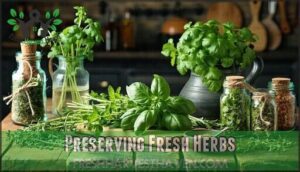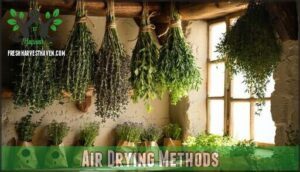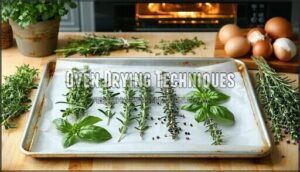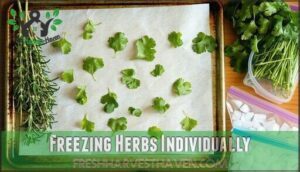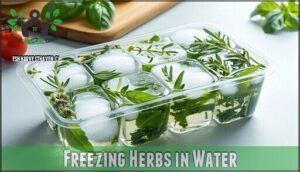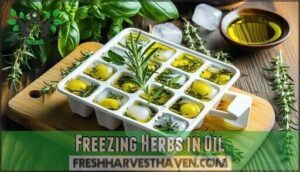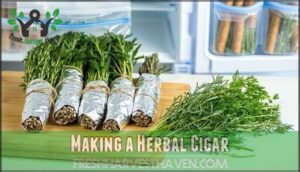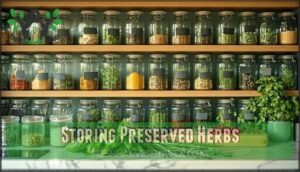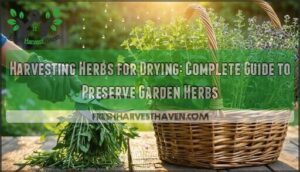This site is supported by our readers. We may earn a commission, at no cost to you, if you purchase through links.
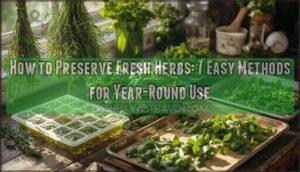 You can preserve fresh herbs seven different ways to keep that garden-fresh flavor all year long.
You can preserve fresh herbs seven different ways to keep that garden-fresh flavor all year long.
Air-dry hardy herbs like rosemary and thyme by bundling stems and hanging them upside down.
For delicate herbs like basil, try freezing them in olive oil using ice cube trays – it’s like having flavor bombs ready to toss into pasta.
Oven-drying works great when you’re in a hurry, just keep temperatures low to avoid turning your herbs into crispy disappointments.
You can also freeze whole leaves on baking sheets, then transfer to bags for easy grabbing later.
Each method has its sweet spot depending on the herb type and how you’ll use them.
Table Of Contents
- Key Takeaways
- Harvesting Fresh Herbs
- Preserving Fresh Herbs
- Drying Fresh Herbs
- Freezing Fresh Herbs
- Storing Preserved Herbs
- Frequently Asked Questions (FAQs)
- How do you preserve fresh herbs long term?
- Which herbs should not be dried?
- How do you preserve herbs?
- How do you keep herbs from going bad?
- Why should you preserve fresh herbs?
- Should herbs be dry before preserving?
- How do you keep herbs fresh for a week?
- Do you wash herbs before storing them?
- Is it better to freeze or dry fresh herbs?
- How do you freeze fresh herbs for later use?
- Conclusion
Key Takeaways
- Harvest herbs in the morning before they flower – You’ll capture up to 30% more essential oils when aromatic compounds peak naturally, and you shouldn’t wash them before storing to prevent oil breakdown.
- Use multiple preservation methods based on herb type – You can air-dry hardy herbs like rosemary and thyme, while delicate herbs like basil work better frozen in olive oil using ice cube trays for convenient flavor portions.
- Store preserved herbs properly to maintain potency – You’ll need airtight containers away from light and heat for dried herbs, and labeled freezer bags for frozen herbs to prevent freezer burn and track freshness dates.
- Apply the right ratios when cooking with preserved herbs – You should use about one-third the amount of dried herbs compared to fresh, add dried herbs early in cooking for flavor release, and use frozen herbs in quick sauces where you want a near-fresh taste.
Harvesting Fresh Herbs
Proper harvesting sets the foundation for successfully preserving your fresh herbs throughout the year.
You’ll want to cut your herbs before they flower and harvest them in the morning when their essential oils are at peak concentration.
Cutting Herbs for Optimal Productivity
Smart harvesting transforms your garden into a year-round herb supply. You’ll want to cut herbs before they flower, preserving maximum leaf productivity while encouraging fresh growth.
- Use sharp, clean scissors for precise cutting techniques that prevent stem damage
- Follow the "first in, first out" rule by harvesting lower leaves initially
- Time your harvest timing for early morning when essential oils peak
This herb pruning approach guarantees continuous stem management and superior herb preservation methods.
Preserving Natural Essential Oils
Morning harvests capture up to 30% more essential oils when aromatic compounds peak naturally.
You’ll preserve these botanical treasures by skipping the pre-storage rinse—water accelerates oil breakdown.
For herb infusion success, use dark glass containers and cool storage temperatures below 60°F.
This oil extraction method maintains potency six months longer than clear jars, protecting your herb-infused oil investment beautifully.
Handling Herbs to Avoid Damage
Once you’ve preserved those essential oils, gentle handling becomes your next priority for fragile herbs. Think of them like delicate butterfly wings—they bruise easily.
Herb care requires a light touch:
- Wash herbs gently under cool water, avoiding harsh spraying
- Pat dry with paper towels instead of rubbing or crushing leaves
- Cut stems at an angle above leaf junctions for leaf protection
Proper handling herbs prevents damage that compromises your herb preservation techniques. To maximize yields, understanding the one third rule is essential for maintaining healthy plants.
Preserving Fresh Herbs
Once you’ve harvested your herbs, keeping them fresh becomes your next mission. The trick is creating the right environment that slows down wilting while preserving those precious essential oils.
For short-term fresh storage, treat your herbs like delicate flowers. Trim the stems at an angle, place them in a glass of water, and cover loosely with a plastic bag. This method works wonders for soft herbs like basil and cilantro, keeping them perky for up to two weeks in your fridge.
Wrap fresh herbs in a damp paper towel, seal them in a container, and refrigerate to keep them vibrant and full of flavor.
You can also wrap herbs in slightly damp paper towels before sealing them in containers. This prevents that dreaded black, slimy mess while maintaining moisture.
Want to get creative? Try making herb butters by mixing chopped herbs into softened butter, or create herbal oils by covering herbs with olive oil. Salt preservation works too – layer herbs with kosher salt for a flavor-packed seasoning that lasts months.
Understanding proper herb drying methods is essential for long-term preservation.
Think of preserving fresh herbs as insurance for your taste buds!
Drying Fresh Herbs
When you’ve got more herbs than you can use fresh, drying them is your ticket to enjoying that garden goodness all year long.
Whether you’re hanging bundles like a medieval apothecary or firing up the dehydrator, dried herbs pack serious flavor punch and won’t take up precious freezer space, which is a great way to preserve garden goodness.
Air Drying Methods
Air drying transforms your fresh herbs into concentrated flavor bombs—it’s like magic, but slower! Bundle small amounts with twine, hang upside down in cool, dark spots, and wait two weeks for crispy perfection.
- Use paper bags with holes to catch falling leaves during the drying process
- Keep bundles small to guarantee proper airflow and prevent mold growth
- Hardy herbs like rosemary, thyme, and oregano work best for this method
- Hang in cool, dry places away from direct sunlight for ideal results
For the best outcome, follow proper herb drying techniques to preserve your herbs and achieve crispy perfection with proper airflow and in cool, dark spots.
Oven Drying Techniques
Speed things up with oven drying when patience isn’t your strong suit.
Set your oven temperature to 95-120°F, spread herbs on parchment-lined baking sheets, and prop the door open for airflow.
Check every 30 minutes—most herbs finish drying in 2-4 hours.
This herb drying method delivers quick results while preserving essential oils better than high-heat alternatives.
To achieve the best results, understanding herb drying methods is vital for preserving fresh herbs effectively.
Dehydrating Herbs With Machines
For herb drying methods, food dehydrators beat oven dehydration hands down.
Set your dehydrator at 95-100°F and spread herbs on trays with good airflow. Most herbs finish in 1-4 hours—way faster than air drying herbs!
Follow dehydrator tips like rotating trays and checking dehydration time regularly. Machine safety matters, so don’t overcrowd.
Quality herb machines with proper dryer settings preserve flavor better than ovens, giving you restaurant-quality results at home. Using a reliable herb dehydrator is vital for effective dehydration results.
Microwave Drying Herbs
Speed-drying fresh herbs in your microwave beats waiting days for air-drying. Simply rinse herbs, pat completely dry, then layer between paper towels.
Here’s your microwave drying game plan:
- Set microwave settings to medium power (50-60%)
- Drying time: Start with 30-second intervals
- Check herb texture frequently—they’ll crumble when ready
- Practice microwave safety by watching closely to prevent scorching
- Rapid drying preserves vibrant color better than traditional methods
This herb preservation method delivers restaurant-quality results in minutes, not days. Using a herb dryer tool can enhance the overall drying process.
Freezing Fresh Herbs
Freezing herbs is like hitting the pause button on summer’s garden bounty—you’ll preserve most of their fresh flavor and color for months ahead.
It’s actually easier than drying and keeps your herbs tasting closer to their just-picked selves.
Freezing Herbs Individually
Flash freezing keeps your herbs tasting garden-fresh year-round! Spread tender herbs like cilantro on baking sheets, then transfer to freezer bags.
Bare freezing works perfectly for woody herbs—just strip rosemary leaves after they’re frozen solid. These herb freezing techniques preserve flavor better than you’d expect, giving you restaurant-quality herbs whenever you need them!
For the best results, understanding herb preservation methods is essential to maintaining their flavor and aroma.
Freezing Herbs in Water
When you’re ready to preserve herbs for months, ice cube storage becomes your best friend.
Chop fresh herbs, fill ice cube trays halfway, then cover completely with water—this water preservation method locks in flavor beautifully.
Once frozen solid, transfer your herb ice cubes to labeled freezer bags.
These frozen herb blocks work perfectly in soups and stews, giving you that fresh taste year-round!
For ideal results, consider using herb oil freezing methods to preserve the herbs’ vibrant color and fresh taste.
Freezing Herbs in Oil
Oil preservation takes herb storage up a notch! Mix two cups chopped fresh herbs with ⅓ cup olive oil, then freeze in ice cube trays.
These frozen herb cubes won’t freeze completely solid, making them perfect for scooping. Your herb infused oil blocks add instant flavor to sautés and dressings.
Store frozen herb blocks for months of delicious cooking!
Making a Herbal Cigar
Another clever herb preservation trick involves creating "herbal cigars" by wrapping herb stems like dill, rosemary, or thyme in plastic wrap, then aluminum foil.
Pop these bundles into freezer bags after they’re frozen solid.
This rolling technique keeps whole stems intact for later use in pickling or flavoring dishes.
Sure, they’ll look a bit limp after thawing, but the flavor stays strong!
Cigar storage in your freezer means you’ll have perfectly portioned herbs ready whenever recipes call for them.
Storing Preserved Herbs
You’ve done the hard work of preserving your herbs, but proper storage is what keeps them flavorful for months to come.
Think of it like organizing your spice cabinet – the right containers and labels make all the difference between herbs that taste amazing and ones that have turned into expensive dust, which is why complete concepts like storage and organization are crucial.
Storing Dried Herbs in Airtight Containers
Once you’ve frozen your herbs, proper storage of your dried varieties becomes equally important. Think of airtight containers as protective shields for your herb collection—they lock in flavor while keeping moisture and light at bay. Mason jars work perfectly, offering clear visibility and tight seals that preserve potency for months.
Position your herb shelves away from direct sunlight, preferably in a cool pantry or cabinet. Heat and light are flavor thieves that’ll rob your herbs of their punch.
Smart herb storage tips for maximum freshness:
- Use container labels with harvest dates to track freshness
- Store whole leaves instead of crushing them beforehand
- Keep dry herb packs in dark spaces for longevity
- Test airtightness by gently squeezing sealed containers
Proper storage also involves using airtight storage to maintain freshness.
Storing Frozen Herbs in Labeled Bags
Pack your frozen herbs like you’re preparing for a culinary treasure hunt – proper storage makes all the difference! Choose high-quality freezer bags to prevent freezer burn, then label each bag with the herb name and freezing date.
Portion herbs into single-use amounts so you won’t thaw more than needed.
| Storage Method | Best For | Shelf Life |
|---|---|---|
| Freezer bags | Most herbs | 6-12 months |
| Ice cube trays | Herb-oil blends | 8-10 months |
| Vacuum sealed | Delicate herbs | 12-18 months |
| Glass containers | Small portions | 6-8 months |
Smart Frozen Herb Storage and Bag Labeling keeps your herb collection organized.
These Herb Freezing Tips guarantee you’ll always know what’s what, avoiding those mystery herb moments that make cooking an unwanted guessing game.
Using Preserved Herbs in Cooking
Now that you’ve got your herbs properly stored, it’s time to put them to work in your kitchen.
Using preserved herbs effectively means understanding their unique flavor profiles and cooking techniques.
Dried herbs work like flavor time bombs – add them early to soups, stews, and braises so they can release their concentrated goodness.
Frozen herbs shine in quick sauces and herb infusions where you want that almost-fresh taste.
- Create custom herb blends by mixing different preserved herbs for signature seasoning mixes
- Try recipe ideas like herb-crusted proteins or herbinfused oils using your preserved stash
Remember the golden ratio: use about one-third the amount of dried herbs compared to fresh for balanced flavor preservation in your culinary herb preservation adventures.
Frequently Asked Questions (FAQs)
How do you preserve fresh herbs long term?
Preserve perfectly: Freeze herbs in ice cubes with oil, dry by hanging upside-down for weeks, or make herbed butter. These methods keep your garden’s goodness fresh for months!
Which herbs should not be dried?
Tender herbs like basil, cilantro, parsley, and chives don’t dry well because they lose flavor and turn brown. You’ll get better results freezing these delicate herbs instead of drying them.
How do you preserve herbs?
You can freeze herbs in ice cube trays with oil, dry them by hanging bundles, or store fresh ones in water-filled jars in the fridge for weeks.
How do you keep herbs from going bad?
Store them like cut flowers—trim stems at an angle, place in water, cover with plastic, and refrigerate.
Change water every few days to keep herbs fresh for up to two weeks without wilting.
Why should you preserve fresh herbs?
You’ll save money, reduce waste, and always have flavorful herbs on hand for cooking.
Fresh herbs spoil quickly, but preserving them extends their life from days to months, ensuring you don’t throw away expensive produce.
Should herbs be dry before preserving?
Yes, you’ll want completely dry herbs for most preservation methods.
Moisture’s the enemy here—it’ll cause mold and spoilage faster than you can say "soggy basil."
Pat them dry thoroughly before freezing, drying, or storing.
How do you keep herbs fresh for a week?
Don’t let your herbs turn into expensive green confetti! Treat them like flowers—cut stems at angles, place in water, and refrigerate. Change water every few days for freshness.
Do you wash herbs before storing them?
Don’t wash herbs before storing them—moisture speeds up spoilage.
Instead, gently brush off dirt and debris, then store unwashed herbs in proper containers to maximize freshness and prevent early decay.
Is it better to freeze or dry fresh herbs?
Think of it as choosing between a time capsule and a treasure chest.
Freezing preserves flavor better and keeps herbs closer to fresh, while drying creates convenient pantry staples that last longer but lose some punch.
How do you freeze fresh herbs for later use?
Flash-freeze herbs on a cookie sheet overnight, then transfer to freezer bags. Or chop them into ice cube trays with water or oil for convenient portioning in recipes later.
Conclusion
Apparently, your grandmother’s wilted herb collection isn’t the only way to preserve garden goodness anymore.
Now you’ve got seven solid methods to keep your herbs tasting fresh instead of like cardboard.
Whether you’re air-drying rosemary bundles like rustic decorations or freezing basil in oil cubes for instant flavor hits, you’ll never waste another expensive bunch from the store.
Learning how to preserve fresh herbs means you can cook with confidence year-round, knowing your spice game stays strong.
- https://www.compoundchem.com/2014/03/13/chemical-compounds-in-herbs-spices/
- https://www.spiceography.com/dried-herbs-vs-fresh/
- https://cucina-antica.com/blogs/our-blog/37132037-dry-herbs-vs-fresh-herbs-advice-from-chef-neil
- https://gardentherapy.ca/preserving-herbs/
- https://savvygardening.com/preserving-garden-fresh-herbs/

